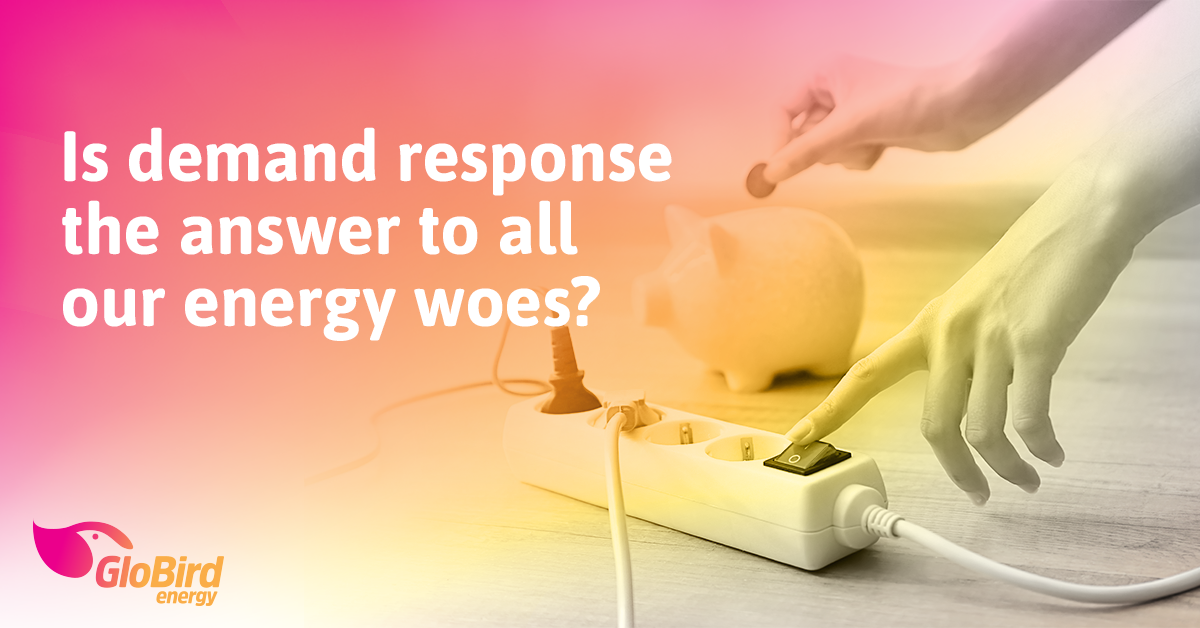About a week ago, The Australia Institute – an independent public policy think tank based in Canberra – released a report Keeping up with the competition: Global trend to demand response.
It makes a lot of interesting points about how demand response could impact on the Australian energy market, not least by reducing prices.
As a progressive retailer, we can see the potential in this approach, and we’re keen on seeing prices fall or at least stabilise.
What is demand response?
According to America’s Federal Energy Regulatory Commission, demand response involves “changes in usage by end-use customers from their normal consumption patterns in response to changes in the price of electricity over time, or to incentive payments designed to induce lower electricity use at times of high demand”.
This blog post by ARENA, the Australian Renewable Energy Agency, uses a good analogy: if you were to find your flight was overbooked, the airline would probably offer some sort of incentive – by way of compensation, such as a future flight voucher – for a couple of passengers to switch to a later flight.
Meanwhile, The Australia Institute’s report suggests:
“Demand response has many benefits including increasing competition, reducing the cost of electricity and improving grid reliability. The International Energy Agency states that the reliability services from demand response are also valuable in managing the safe retirement of coal-fired power stations.”
However, it doesn’t really explain how it directly reduces the cost of electricity, other than at peak times.
Is demand response common elsewhere?
The implementation of demand response is on the rise in some of the most populous countries or regions, such as parts of China (the world’s biggest energy market), Japan, the US, and Europe.
Japan sees demand response as a component of the way forward in the wake of the Fukushima nuclear disaster.
South Korea is also well down the track with a substantial portfolio available if needed, as are some groups of US states, as well as Texas.
The European Union is in the process of opening up wholesale electricity markets to demand response, with new legislation due to take effect at the start of 2020.
It does appear that a high concentration of consumers in a smaller region makes demand response more of a favourable option at times of peak demand.
It also appears to work well when there are certain types of larger industries or businesses that are easily able to regulate their times of operation.
What’s the problem?
It certainly makes more sense to have a mechanism to reduce usage on those handful of extremely hot Aussie summer days when everyone cranks up the air-con than to fire up a natural-gas-fired plant for a few hours (at a high cost).
That’s hard to argue with.
However, if we only need to reduce the load on the grid by a couple of percentage points for a few hours on a handful of days each year, does it make sense to put in place something far more extensive? And if we do, what’s the actual, tangible impact?
If we are to incentivise those who volunteer to participate in a demand response scheme, either through payments or credits reducing their bills, who will most likely take advantage and benefit? Will some benefit at the expense of others?
And if we’re going to institute any new mechanism that relies on the actions of end consumers, is that equitable? After all, numerous studies have found that most of us would rather settle for the status quo than be asked to make an effort to contribute to change – even if that change is positive for us, such as saving us money.
How we see things
There is a place for demand response, but probably at the industrial user level rather than a household-by-household solution.
People already know that if they switch off their pool filters and other less-than-necessary energy-consuming appliances at any time, let alone only at times of peak demand, it saves them money and takes a load off an overworked grid.
At the same time, demand response shouldn’t be seen as a panacea. That is, it’s not the magic bullet solution to everything that we’re not happy about in the Australian electricity market.
Every proposed change that tweaks things and tinkers around the edges has as much potential for undesired knock-on effects as it does to provide relief.
Not to mention that demand response, like a number of other things that have either been suggested or are already in operation – including rooftop solar – has the potential to further disadvantage those who can least afford it, including lower-income households, pensioners, and renters, who may not be in the position to participate in such options.
We still want to see a considered, policy-driven, consumer-sensitive and holistic approach.
The best thing is that the cost of energy is kept to a minimum for everyone, rather than creating more optional ‘levers’ that potentially reward some while leaving others behind.
Everyone should be able to access the supply they need when they need it, without having to jump through hoops.
As we noted in last year’s blog post How the ACCC inquiry into electricity prices is trying to help you, we fully support any recommendations that:
· Boost competition in generation and retail markets;
· Lower network costs;
· Ensure cost-effective and equitable environmental schemes; and
· Improve outcomes for small customers.
The Australian energy market is unique so, while there’s no doubt that we can learn from what’s being done elsewhere, it’s far too simplistic to say: “just do what they’re doing”.
We’ll soon see, anyway
Demand response is already being tested here.
We’re coming to the end of a three-year trial program, instituted by ARENA in May 2017, which put up $30 million to support demand response demonstration projects across the national market.
It will be interesting to see how that shakes out, after the coming summer.
Perhaps $10 million a year will be all the funding required?
We’ll keep you posted.




